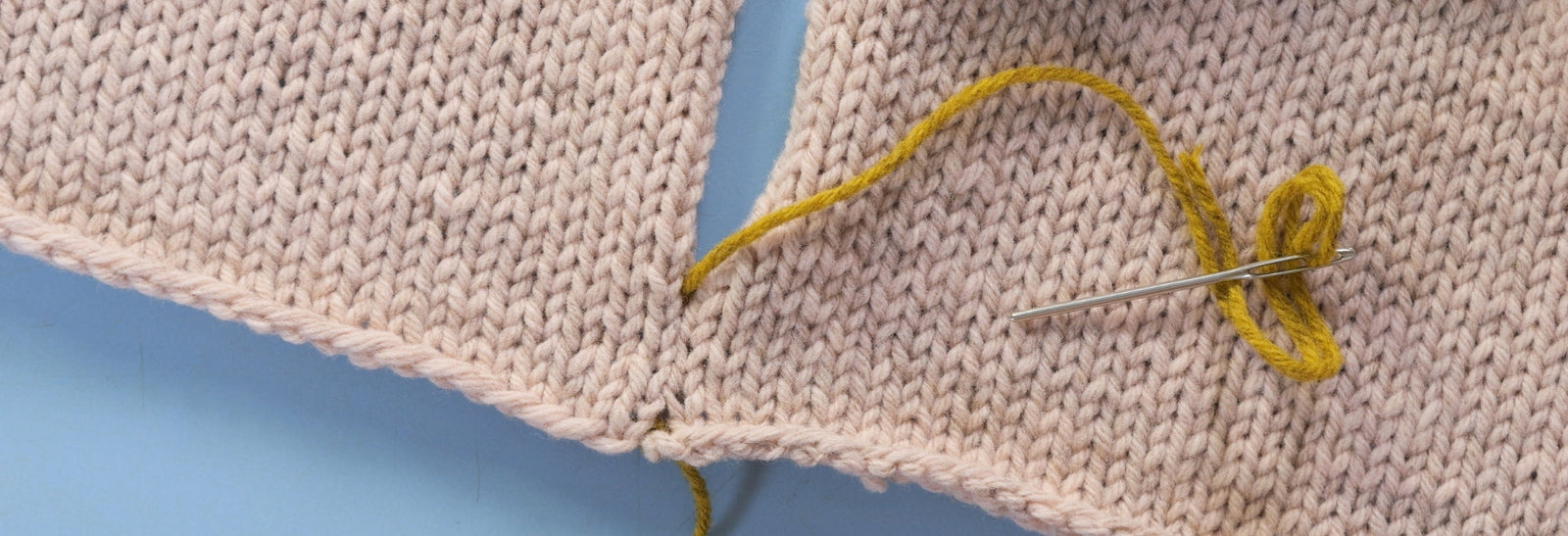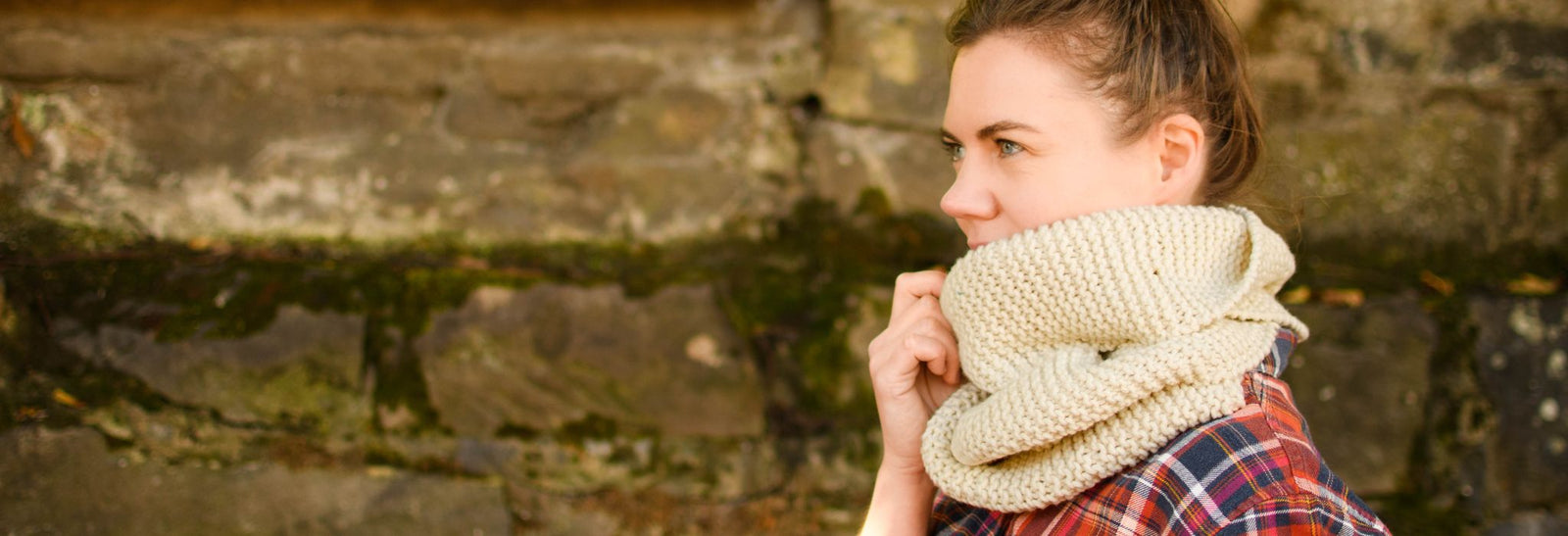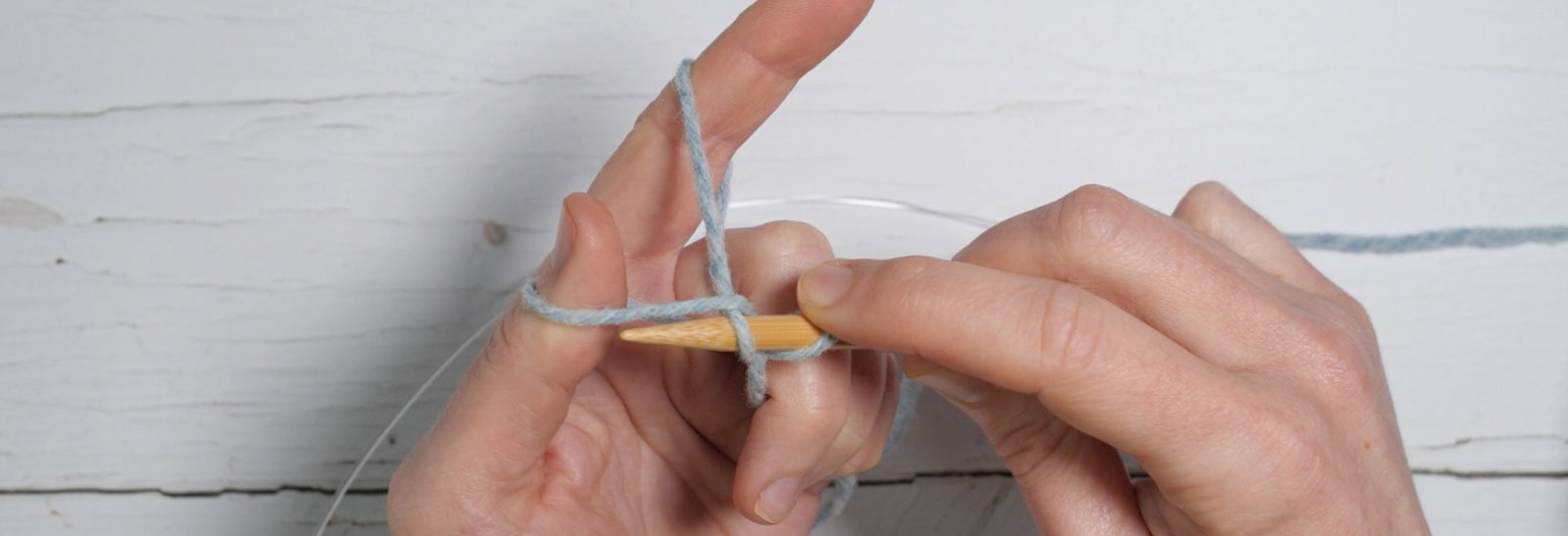Your Cart is Empty

How to swatch in the round: the easy way
June 05, 2014

It's important to swatch in the round for any knitting project that will be worked in the round, whether you're knitting a sweater, a hat, or a cowl. New to knitting? Swatching is an important part of the process of knitting any project where the finished size matters - you probably want your new sweater to fit you instead of your friend who's 3 sizes smaller! Before learning how to swatch in the round you might want to brush up on the basics of swatching, and why gauge (which is what you're checking when you swatch) matters.
Swatching in the round can be a pain, and it's often inaccurate. Use a simple trick to make swatching in the round easier and more accurate!
Why does it matter whether you swatch in the round?
It's always a good idea to make a swatch that matches how you'll knit your project, you want it to be an accurate test of how your fabric and gauge will turn out in the project. Knitting in the round adds an extra complication because instead of alternating right side and wrong side rows you're only working right side rows. That means that if you're working stockinette, or any stockinette based stitch pattern, you'll only be knitting and not purling.
There are many ways to knit, but whichever style you work in one thing remains constant: knits and purls are never worked in exactly the same way. Consequently it’s very common for knit and purl stitches to be slightly different sizes. This can cause a range of visible tension inconsistencies and next week’s post will cover dealing with those. It also means that it’s common to find a difference in gauge between stockinette worked flat (with purls) and stockinette worked in the round (no purling).
Option 1: knit the swatch in the round as a narrow tube
Beginning with a sleeve is often recommended as a way to avoid swatching for a sweater but it's not a very reliable method. The reason is that sleeves are smallish tubes and you’ll be using magic loop, dpns, or circulars with shortened tips to knit them. You might grip those short needles tighter to avoid them flying everywhere;, pull the yarn tight to avoid ladders at the joins; or just tense up a bit. The odds of your gauge being tighter than it normally would be on that needle size are high. We find that it's very common for our sample knitting team to use a larger needle size on sleeves than than they used for the body of a seamless garment.
Option 2: knit a really big swatch as a tube to avoid magic loop, dpns, etc
Knitting a swatch with a 16″ / 40cm circumference so that the stitches fit around a circular needle, or even one with a 24" / 60cm circumference so that you can use regular length needle tips, is possible. It will probably result in a very accurate swatch and a lovely, large piece of fabric where you can really see how your garment will behave. It's also a lot more knitting than the vast majority of us want to do for a swatch, particularly if you find the gauge is off and you have to make another!
Option 3: The easy way to swatch in the round
It’s not knitting a tube that matters for swatching in the round. The crucial thing is whether or not you’re working wrong side rows.
For a swatch with no wrong side rows use the following method:
All you need is your yarn and a circular needle (preferably the needle you plan to work the project with, or at least one in the same material).
Begin by casting on at least 1 and a half times your desired gauge over 4" / 10cm. Eg. if your desired gauge is 20sts per 4" cast on at least 30 stitches. This method results in several loose stitches at either side, which you won't want to measure.

Knit 1 row, without turning at the end.


Slide all of the stitches to the other end of the needle, just like making an I-cord.


Bring the yarn around the back of the work and knit across with right side facing. At the end of the row slide the stitches along the needle again. Continue in this manner, letting the yarn trail loosely across the back.


If you find it difficult to keep the strands loose just let them tighten up.


You can cut them at the end so that the swatch lies flat. Make sure you have plenty of yarn for your project before cutting the swatch though!


This method is perfect for swatching for stranded colourwork, which most knitters find it easier to work in the round. If you're interested in learning more about colourwork knitting, our colourwork club is the perfect, structured way to develop your skills at your own pace and in a supportive community.

Looking for other swatching tips? Read our free tutorial on how to swatch for a sweater here and find our article on how to swatch in a stitch pattern here. How do you swatch in the round? Please do let us know in the comments if you have any tips to share!
Also in Journal

Learn to Knit: Mattress Stitch
March 29, 2023
By following our step-by-step mattress stitch knitting tutorial, you'll learn how to make your seams look beautiful and how best to prepare your knitting so that when you seam it with mattress stitch, it goes smoothly on the first try.
Read More
How to Knit a Scarf: A Beginners Guide to Scarf Knitting
March 23, 2023
Want a quick and easy beginners tutorial on how to knit a scarf? This garter stitch scarf is easy to knit and requires just 3 skills; casting on, the knit stitch and casting off.
Read More
Learn to knit: the long tail cast-on
February 03, 2022
The long tail cast on is a great multi-purpose knitting cast on and the perfect place for beginner knitters to start. Learn how to work the long tail cast on and how to estimate the length of yarn needed with our clear step by step tutorial and video.
Read More Recent Articles
- Learn to Knit: Mattress Stitch March 29, 2023
- How to Knit a Scarf: A Beginners Guide to Scarf Knitting March 23, 2023
- Learn to knit: the long tail cast-on February 03, 2022
- How to Kitchener Stitch December 09, 2021
- Crochet Provisional Cast-on December 02, 2021
- Learn to knit: How to knit in the round with double pointed needles November 25, 2021
- Learn to knit: How to knit in the round using the magic loop technique November 25, 2021
- Learn to knit: How to knit in the round November 25, 2021
- Knitted Gift Ideas for you and your loved ones November 18, 2021
- Celebrating our Porty Hat Preview Knitters October 28, 2021
Free resources
-
KALS, step-by-step pattern guides and free patterns
Learn brioche with the free Daniel's Hat pattern
Tombreck - a free chevron beanie pattern
Working the brioche neck detail on the Polwarth sweater
Installing a zipper and ribbon, finishing wee Carson
Yarn colour ideas for Threipmuir sweater
Additional colourways for the Joy mitts (choose your pride flag)
How to join the shoulders on Wardie
How to join the pockets on Granton and Wardie
Finishing Resources for Granton
Broughton mittens tutorial part 1
Broughton mittens tutorial part 2
Broughton mittens tutorial part 3
Basics
Casting on
Decorative Channel Island Cast-on
Binding off
3 Easy Stretchy Bind-offs (p2tog bind-off; k2togtbl, k1 bind-off; Jeny's surprisingly stretchy bind-off)
Tubular Bind-off for brioche stitch
Increasing
Paired increase methods compared
How to continue in pattern while increasing and decreasing
Decreasing
Brioche stitch double decreases
Knitting in the round
How to Knit in the round using Magic Loop
How to Knit in the round using DPNs
Short rows
Swatching and gauge
Tips and tricks
Avoiding ears when binding off
Tighter purl stitches for neater cables and ribbing
Cabling without a cable needle
How to knit more symmetrical yarn overs
Bust darts in sweaters with all over stitch patterns
A magic formula for evenly distributing shaping
Superwash v Non-Superwash Wool
Picking up sts from the middle of the fabric
Reading knitting patterns
Understanding "continue in pattern"
Help! Where am I in my knitting project?
Using charts, even if you hate them
Finishing
Garment knitting
Joining the body and sleeves on a seamless bottom up sweater
Sizing
Ysolda’s sizing chart for knitwear designers
Inclusive garment knitting
How to pick a garment without a model for you (specifically addresses finding garment patterns when your gender identity isn't represented and the styles you want to knit might not be sized to fit your body)
How does ease affect inclusive size ranges?
Specific stitch patterns
Lace
Identifying and fixing mistakes in lace knitting
Colourwork
Getting started with stranded colourwork
Understanding colour dominance
Working stranded colourwork over small circumferences
Decreases in stranded colourwork
Holding the yarn for stranded colourwork
Ladderback Jacquard (a neat way to deal with long floats)
Cables
Cabling without a cable needle
Cabling without a cable needle on the wrong side
How to knit cabled decreases
Closed ring cable increases and decreasesBrioche
How to work brioche stitch in the round
Other crafts
Cross stitch
How to begin your first large cross stitch project
How to finish a cross stitch project with an embroidery hoop frame
Mending

Sign up today
Find out the latest news from the studio such as sales, pattern releases, and new workshops or KALs our learning community, The Knitwork. We also share helpful tips and exclusive subscriber discounts...

